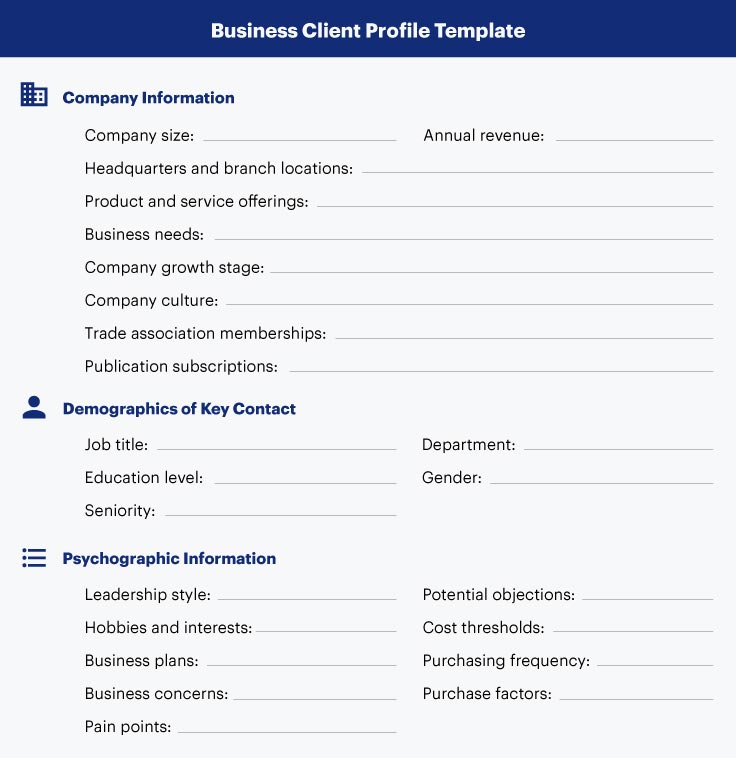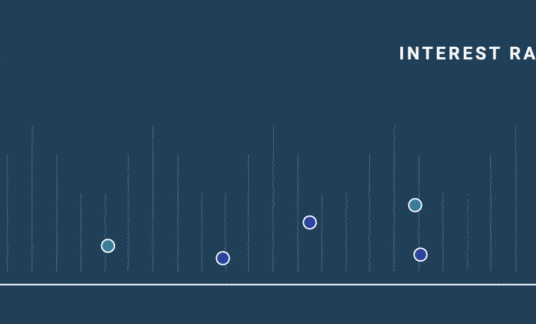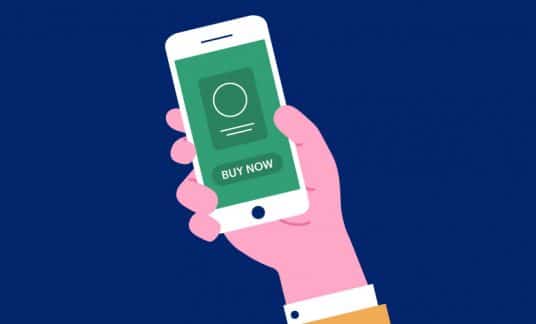Your products and services are only as good as your ability to market them to the people who need it. A customer profile template lets you find out what you need to know to create your target customer profiles.
Let’s look at the definition of a customer profile as well as examples and templates you can start using immediately.
What Is a Customer Profile?
A customer profile describes your target audience based on various factors, which could include demographics, background, interests and abilities. This information helps you identify points that make your product or service helpful and attractive to your customers. Customer profile templates can help you do this.
A detailed look at how your target customer acts will help you align how you present your products or services to them. According to a 2017 survey by Epsilon, 80% of consumers are more likely to buy when a business offers them a personalized experience. What’s more, your time will be optimized because you’ll be cultivating more meaningful leads and getting them closer to becoming a conversion.
What Is a Customer Profile Template?
A customer profile template is a document that serves as a guide to help you build your target audience profile, also known as a buyer persona. After collecting data prompted by your template, you may find you’ll need to create several customer profiles.
You might use several customer profile templates depending on how diverse your customer base is. The goal? Identify the needs and desires of your target audience and use those to influence your marketing strategy.
Template Details
Your customer profile template could include:
- Demographics
- Motivations
- Pain points
- Buyer goals
- Fears
- Needs
- Habits and lifestyle
- Hobbies
- Social media activity
- Personality
- Business background
Let’s look at a few of these in a bit more detail.
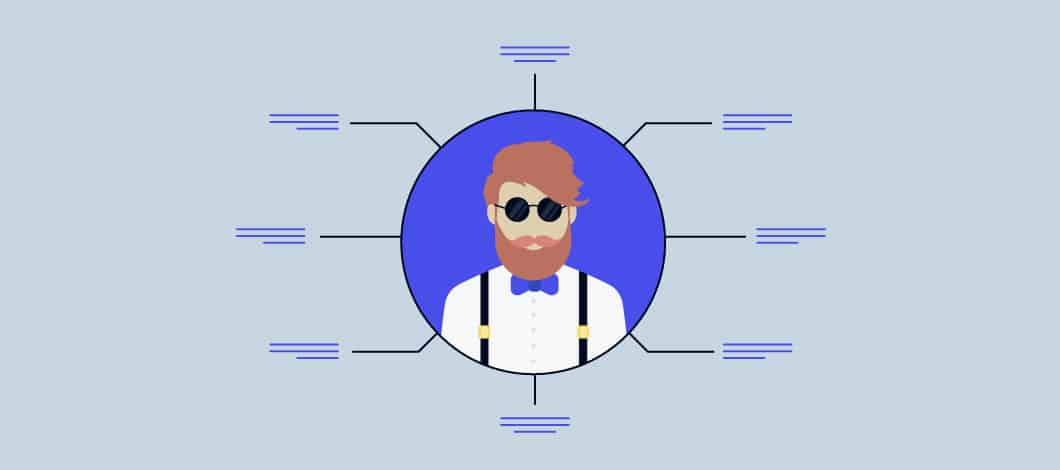
Customer Profile Elements
The more detailed you are with your customer profile template, the better. Your customer profile template will evolve as you learn more about your clients. You may uncover marketing opportunities to help you make deeper connections with your prospective and established customers.
Here are elements to include in your customer profile template:
Demographics
Demographics are crucial to include in a customer profile, as they shed light on typical buying behavior. You can look at market research that relates to your customer demographics to better understand motivations, pain points and solutions your target customers are looking for.
In the demographics section of your customer profile template include:
- Age
- Gender
- Education
- Employment and job title
- Income
- Net worth
- Marital status
- Home ownership or renting status
- Geographical location
- Race or ethnicity
These demographic factors can influence how to market your target audience. The language you use, the social channels you focus on and the way you position your products or services will be influenced by demographics.
Pain Points, Needs and Desires
Your products or services should be a solution to your target customer’s issues, namely their pain points. In this section of the customer profile template, you need to identify what problems your target audience has and how you can position your business as the solution.
On your customer profile template, ask questions such as:
- What does this customer worry about?
- What’s the most frustrating part of this customer’s day?
- What does this customer need to lead a better life?
- What are your customer’s goals and desires?
Habits and Behaviors
Our customer profile template should include a typical day in the life of your target customer. Include questions such as:
- What does the customer do in their free time?
- What are the customer’s shopping habits?
- How does the customer interact with technology in terms of devices used, websites visited, keyword search terms used and apps utilized?
- What are this customer’s interests and hobbies?
- What are the customer’s personal relationships like?
Knowing how your customers spend their time will present opportunities for positioning your product or service during those moments.
Potential Interactions With Your Products and Services
In addition to understanding how your target customer behaves, you need to include details about the relationship your target customer would have with your product or service. Things to consider:
- Objections a target customer might have to your product or service
- Channels a target customer uses that might expose them to similar products/services
- Aspects of products and services that make the target customer most likely to convert
These insights will help inform the typical buyer journey each of your target customers will take, from lead to customer to brand advocate.
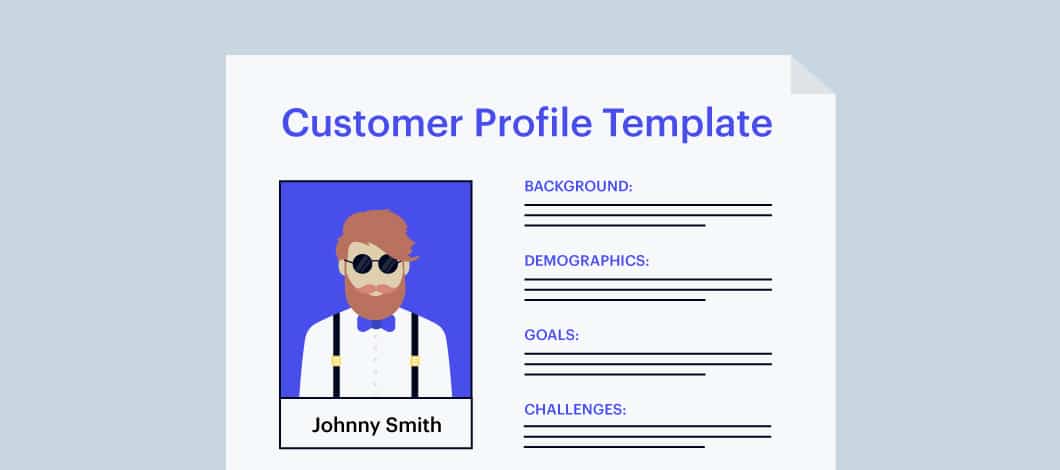
Why Use an Ideal Customer Profile Template?
Once you’ve created a sample customer account profile template and forged a profile, you should have a better understanding of:
- What problem you’re solving
- Which marketing channels you should use
- The type of content to present to your audience
- How to reach targeted leads with ads
- What creative copy and photographs to use
- Which promotions and campaigns to run
How to Create Customer Profiles
1. Start With a Free Customizable Template
There are many free customer profile templates available online that you can use to create your audience profile. A quick Google search provides a lot of results. For example, HubSpot, an inbound marketing software tool, has free templates you can download online, such as this one:
When you’re searching for templates, see what information you’ll need for your customer profile to get ideas for how you’ll organize it.
Here’s an ideal customer profile template from small business branding and website-building company January Made Design:
If you’re looking to develop a marketing customer profile for a business client, consider this option below:
2. Research Your Customer Base
Take stock of your clientele:
- You might already be using a customer relationship management tool that has built-in analytics, where you can pull demographic information. You also can use your website analytics tool to find customer trends.
- Consult with your team members who interact with your customers most often, such as salespeople, customer service members and social media managers. Ask for patterns and trends they see among the customers they interact with.
- You might want to create a customer survey to get information on the answers you want for your customer profiles. You can use something as simple as Google Forms to create a survey. Get more responses by entering all respondents into a contest for a giveaway.
- You also can conduct in-person focus groups with your customers to get detailed insights. Have one-on-one telephone or video chat conversations with your most loyal customers who can’t meet you in person.
- To gain more insights, add a feedback form to your website and promote it on social media and in your email marketing.
Look at all your digital marketing efforts and aim to increase the amount of information you gather at each touchpoint for a better customer profile analysis. If someone is contacting you for customer service, for example, send out a follow-up survey after the interaction to capture more details about your customers.
3. Consult Market Research
Once you know the general demographics of your customers, you can use market research to find more insights.
For example, if most of your customers are women in their 20s, it’s easy to consult sources such as Pew Research Center to find insights into the social media- and mobile device-usage habits of that demographic. You can add those to your descriptions in your customer buyer templates.
4. Craft Customer Messaging Points
You can make your target audience profiles more helpful by adding recommendations for how to interact with each customer. These recommendations can include:
- Types of language and imagery to use when marketing to this customer
- Pain points to address in order to close the sale
- How to respond to typical objections from this customer
These types of marketing customer profile insights will help different teams refine their interactions with these target clients.
5. Share Each Business Customer Profile Analysis Among Your Team
Put your target customer profiles to work for your business by sharing them among your team. Make them living documents that you can update as you gain new information.
Customer Profile Examples
Here’s an ideal customer profile template example that HubSpot completed. We see information about background, demographics, goals, challenges and more.
Here’s a business-to-consumer customer profile analysis from content marketing agency Brafton. The buyer persona includes age range, gender, wants, challenges, preferred marketing channels and content type.
This business-to-business customer profile example is from GetFeedback by Survey Monkey. Here we see insights into the key contact as well as gather information about business goals, challenges, solutions and messaging.
Build Your Business with Well-Crafted Audience Profiles
Now that you’ve reviewed a few examples of customer profile template outlines as well as finished examples, start working on creating yours today.
- Define your customer profile
- Refine your products and services
- Use your marketing customer profiles to choose the best channels to optimize your time and money
- Make sure what you’re selling fills a need
Once you have targeted audience profiles in place, you can work on expanding your small business and focus on marketing your products and services to the right buyers.








